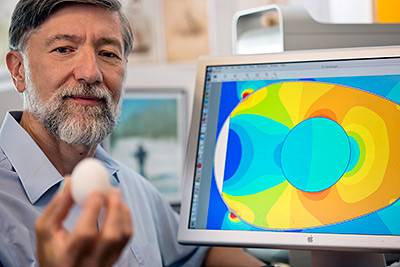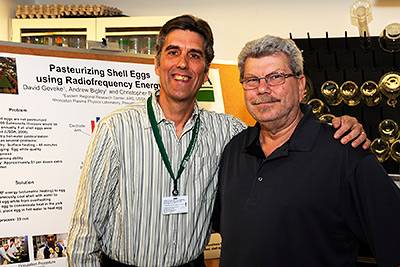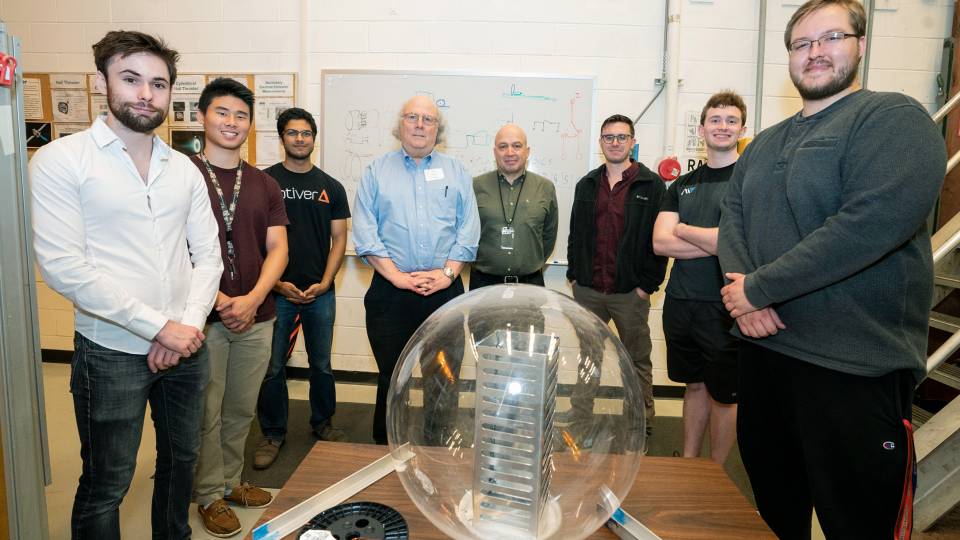Researchers at the Princeton Plasma Physics Laboratory (PPPL) and the U.S. Department of Agriculture (USDA) have developed a novel technique and device for rapidly pasteurizing eggs in the shell without damaging the delicate egg white. The process could lead to a sharp reduction in illnesses caused by egg-borne salmonella bacteria, a widespread public health concern.
The new method uses radio frequency (RF) energy to transmit heat through the shell and into the yolk while the egg rotates. Streams of cool water simultaneously flow over the egg to protect the white. Researchers then bathe the egg in hot water to pasteurize the white and finish pasteurizing the yolk.
The aim is to produce a pasteurized egg that is "hardly discernible from a fresh, nonpasteurized egg," said David Geveke, lead scientist, at the USDA Agricultural Research Service in Wyndmoor, Pa. His laboratory teamed up with PPPL engineer Christopher Brunkhorst, an expert in RF heating, to develop the device.

PPPL engineer Christopher Brunkhorst displays an egg while a computer image simulates the levels of radio frequency power that different parts of an egg absorbed during an experiment. (Photo by Elle Starkman, PPPL Office of Communications)
The roughly shoebox-size prototype can pasteurize shell eggs in about one-third of the time that current methods require, Geveke said. Such methods place the eggs in heated water for about an hour and visibly change the appearance of the egg white. The RF process, by contrast, maintains the egg white's transparency.
Federal regulations require pasteurization of raw liquid egg products used in commercially sold dishes such as ice cream, eggnog, sauces and dressings, but no similar rule covers eggs in the shell. Fewer than one-half of 1 percent of all shell eggs produced for retail sale in the United State are pasteurized, according to an estimate by the Food Safety and Inspection Service of the USDA.
While only a small fraction of shell eggs may harbor salmonella, the public health risk posed by consumption of raw or undercooked eggs stems from the fact that millions of eggs are eaten each day. The hazard is greatest for people with weakened immune systems, including the very young, the very old and hospital patients. The USDA estimates that pasteurizing all U.S.-produced shell eggs could reduce the number of egg-borne salmonella illnesses by up to 85 percent, or more than 110,000 cases a year.

USDA researchers David Geveke (left) and Andrew Bigley, who collaborated with Brunkhorst to develop a new method for pasteurizing shell eggs, are based at the Agricultural Research Service in Wyndmoor, Pa. (Photo by Joseph Sites, USDA)
Brunkhorst, a 30-year veteran of PPPL and member of the lab's engineering and scientific staff, has helped design large RF heating systems for fusion energy experiments. He began assisting the Wyndmoor-based project in 2010 after working with the USDA on previous ventures.
"It's turned out to be a really good fit," said Brunkhorst, who co-invented the pasteurization device with Geveke and USDA engineering technician Andrew Bigley.
They benefited from joining forces because pasteurizing shell eggs can be a tricky task.
"You have to raise the temperature high enough to kill bacteria, but not high enough to cook the egg," Brunkhorst said. "You're really threading the needle on this."
Further complicating the process is the fact that the egg white is more sensitive to overheating than the yolk is. But the RF energy must pass through the white in order to reach the yolk, which requires a higher temperature to pasteurize.
The system works through what is known as "ohmic heating," in which the RF energy creates an electric current that produces heat inside the egg. Food-processing firms employ a similar system for heating, baking and drying a wide range of products. Brunkhorst brought test equipment into his own kitchen to experiment with RF frequencies that the researchers then tried out in the Wyndmoor laboratory.
The USDA prototype, which the agency has applied to patent, couples RF energy through the shell by placing electrodes against opposite sides of the egg. The egg rests on rollers that turn it to distribute the heat and cooling water evenly.
"The goal is to reach a certain temperature for a certain time," Brunkhorst said.
Researchers then take a sample of the egg and do a bacteria count.
"We've proven the effectiveness analytically," Brunkhorst said.
The USDA is seeking a licensee to commercialize the product. Potential partners include egg producers and manufacturers of egg-processing equipment.
"We have received quite a bit of interest from industry," Geveke said. "We expect to have a partner in the next few months."
PPPL, on Princeton University's Forrestal Campus in Plainsboro, N.J., is devoted to creating new knowledge about the physics of plasmas — ultra-hot, charged gases — and to developing practical solutions for the creation of fusion energy. Results of PPPL research have ranged from a portable nuclear materials detector for anti-terrorist use to universally employed computer codes for analyzing and predicting the outcome of fusion experiments. The laboratory is managed by the University for the U.S. Department of Energy's Office of Science.

